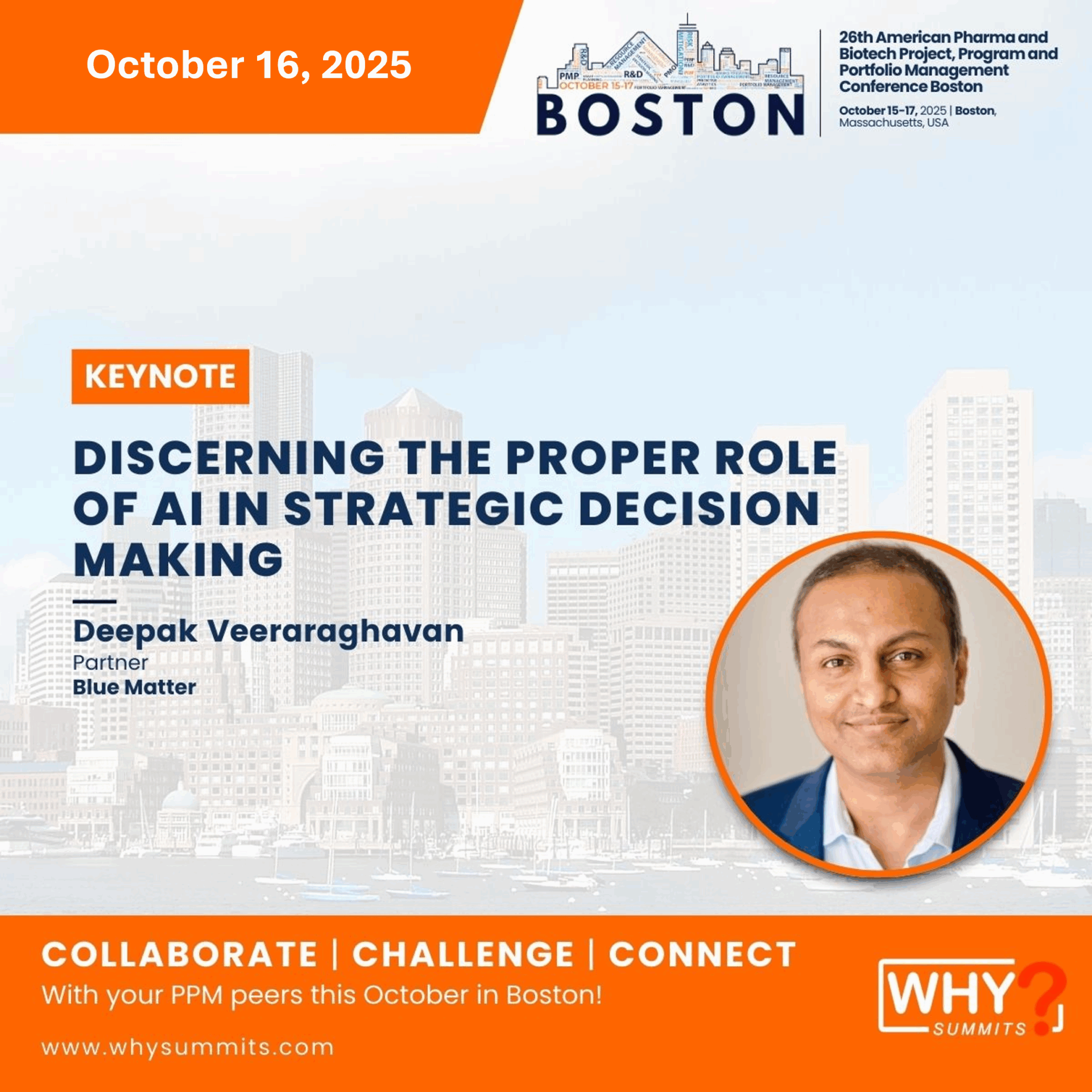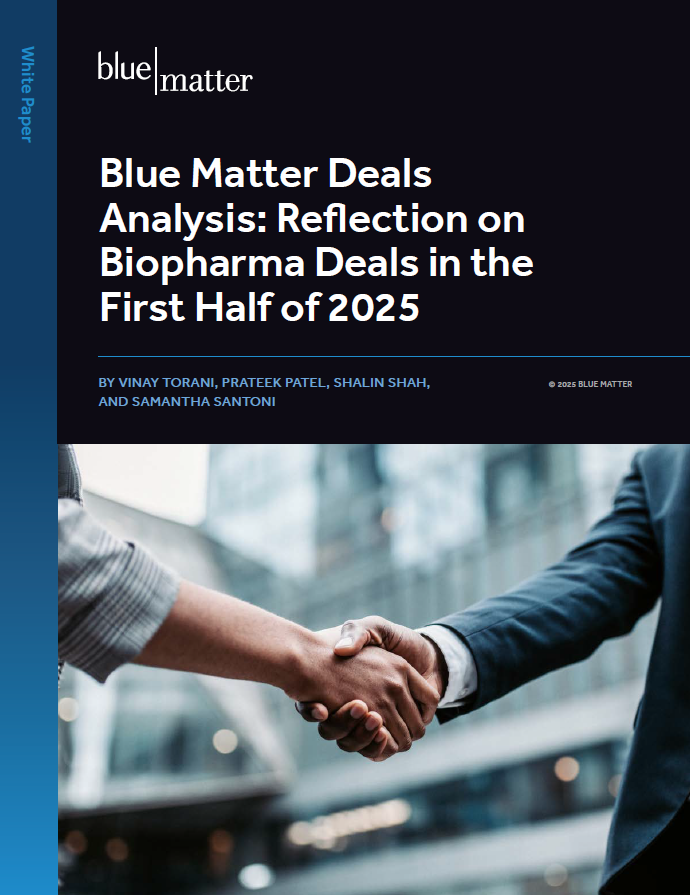
Summary
This summer, Blue Matter’s London team hosted the second meeting of the UK Biotech Club, inviting C-suite leaders and directors from 15 biotech companies in the Cambridge biotech sector. These companies are developing diagnostics, vaccines, discovery platforms, small molecule therapeutics and biologics, covering all lifecycle stages from discovery through to commercialization. Attendees discussed challenges, opportunities, and best practices for achieving success in the UK biotech scene and beyond. Topics included determining vision and direction, relationship building, extending the runway, and strategies for go-to-market success. In this article, we share insights from these discussions and draw out the key takeaways.
Introduction
At the end of 2021, AstraZeneca launched The Discovery Centre (DISC), a $1.34 billion global headquarters and R&D facility for ~2,200 scientists, on the Cambridge Biomedical Campus. The move brought AstraZeneca into proximity of one of the world’s most prestigious academic research institutions: Cambridge University. Given that Cambridge has produced the second most biotech spinout companies in the UK and hosts one of the most productive life science clusters in Europe, it was the ideal location for Blue Matter’s second UK Biotech Club event, following the success of our inaugural event in Oxford.
On June 22, 2023, Blue Matter’s London team held a reception and dinner for C-suite leaders and directors from more than 15 companies in the Cambridge biotech space. These individuals represented companies at different life-cycle stages, from recent spinouts to commercial, that are developing a variety of assets, including discovery platforms, diagnostics, vaccines, and therapeutics. Also present were Business Development directors from AstraZeneca and GSK to contribute the perspective of “Big Pharma” to the discussion.
Throughout the conversation we discussed the current biotech landscape, challenges, opportunities, and best practices for success in the UK and beyond. Using the opinions and information the group shared, our team identified the key insights to help guide innovators through four main stages in the journey of companies in the UK biotech scene:
- Building a Solid Foundation
- Acquiring and Maximising Talent
- Growing a Trusted Network
- Targeting the End-Goal
Building a Solid Foundation
For most biotech companies, their journey begins as a spinout from academic research. Over the past decade UK universities have worked hard to support innovative academics taking the leap into the entrepreneurial space. Early missteps by universities retaining excessive equity are giving way to more progressive practices guided by the level of support required by founders. This support focuses on three key areas: vision, investment, and intellectual property (IP). As investor relationships are critical to securing investment, we will discuss those later and focus on vision and IP here.
Establishing a strong vision with a coherent scientific narrative is one of the critical success factors. Founders need to consider the long-term possibilities for the company, particularly whether they will pursue developing a technology platform or focus their efforts on identifying commercialisable assets.
For many founders, a closer connection to the scientific potential rather than commercial reality, can give rise to an unrealistic expectation of unbounded potential and unlimited possibility. This is a particularly common pitfall for platform companies. One executive recounted how early in their company’s life, they initiated a dozen programmes in different disease areas and burnt out their team. By identifying the best opportunities and narrowing their focus, they have managed to make considerable progress in progressing assets to clinical development.
To deliver on this vision, biotechs need to ensure that they have sufficient access to and control over IP. As noted earlier, risk-averse universities have historically targeted retaining control, limiting the ability of companies to thrive.
While practices are changing to give new spinouts greater freedom in defining their strategy, challenges remain with access to additional innovative technologies that could enhance the business by supplying upgraded or complementary capabilities. By licensing or selling new IP to existing spinouts, universities may be able to increase chances of success and generate greater value than by establishing an entirely new biotech. Success in this domain will require company executives to engage with technology transfer officers and entrepreneurial academics to identify emerging opportunities for synergy. Once spotted, having a strong vision will enable a biotech to capitalise on the opportunity.
Key Takeaways
- Develop and refine a company vision that balances aspiration with reality to ensure that the company focuses its efforts and maximises productivity. The refined narrative underpinning this vision will form the basis for building relationships and securing funding as the company grows and provide a guiding star towards a successful exit.
- Develop new ways of thinking with a “big picture” mindset to increase access to emerging technologies for existing companies. These new pathways to technology transfer from universities will lead to mutually beneficial enhancement of spinouts.
Acquiring and Maximising Talent
One concern on the minds of all the participating executives is making sure that their company attracts and retains the best talent possible. Proximity to Cambridge University (and other biotechs in research campuses) was seen as a strong benefit and a rich source of talent. New hires come equipped with niche skills required for early research programmes and a flexible mindset to tackle new challenges.
However, proximity to other biotechs also presents a double-edged sword. Over the past decade there has been an increase in workforce mobility, with employees more likely to “jump” between biotechs, reducing the overall workforce effectiveness with onboarding and training. This mobile workforce is highest where there is direct mingling of staff in a campus environment with shared facilities and higher levels of inter-company interaction.
Contributing to executives’ concerns is the presence of “Big Pharma,” which can out-compete small companies on many of the motivating factors behind a job change for scientists: better pay, long-term job security, and structured career advancement. On the other hand, as biotechs approach the later stages of development, they need to bring in more commercial skills and mindset. Historically, this has required going beyond the local community. The addition of a large pharma company is seen as being a potential source for talented individuals seeking a new challenge in a more dynamic early-stage company.
Beyond capability acquisition, the transition towards becoming a commercial company demands adopting a new leadership mindset. The majority of spinouts are led by founder-CEOs who are scientists at heart but lack commercial experience. Handing the reins to a more experienced “storyteller” will aid in funding rounds and partnering, especially if the new CEO brings a positive track record and network, enhancing the long-term growth of the company. The best founder CEOs actively consider and plan when to step back into more advisory roles. Experience in the room suggested that most companies transition too late, delaying adoption of a strategic mindset and slowing growth. To ensure a successful transition, CEOs, boards, and investors should work together to regularly evaluate progress towards the vision and ensure that the company has the correct leadership and skill set to maximise success.
Key Takeaways
- Innovative approaches are needed to motivate the team and ensure that there is employee buy-in beyond simple remuneration. Training practices and culture are key for success in a highly competitive marketplace where the barrier to changing jobs is particularly low.
- Successful companies develop a skills roadmap that identifies required capabilities for each stage of their growth. By critically evaluating the ability of individuals to ensure they’re in the right role at the right time and having a supportive environment they can ensure they’re sufficiently dynamic to adapt as their needs evolve.
Growing a Trusted Network
As companies adapt to post-COVID ways of working, successful leaders are developing novel approaches to making and nurturing relationships. The return of face-to-face business networking events and major conferences such as ASCO and JP Morgan are once again providing opportunities to make new acquaintances and reconnect with old ones. To ensure these sometimes-fleeting encounters aren’t forgotten, regular video calling is being used as means to deepen connections. Employees value the flexibility provided by working from home, meaning that executives with young families feel less conflicted to travel or attend evening events as less personal time is lost to daily commutes. By optimising engagement, biotechs are now able to build stronger relationships with their key stakeholders.
However, the consensus in the room was that face-to-face time is more valuable than virtual connections, for both external network connections and internal company meetings. Biotech leaderships must find the balance that enables a strong internal camaraderie while allowing the flexibility to work remotely when advantageous for the individuals.
One of the most important early stakeholder relationships for a biotech is with their lead investor. Choice of a lead investor is pivotal, once confirmed they will open multiple doors and provide much-needed credibility with new and potential investors. Therefore, it is essential to ensure that the lead investor is the correct fit with the company. To do this, a biotech needs to gain buy-in to the company’s narrative for the long-haul. This is more likely to happen when a biotech provides the investor with a strong technical understanding of its offering. In a tight funding environment, taking the time to evaluate and nurture investor relationships may feel costly in the short term but will provide benefits in the long run.
The other relationship which becomes increasingly important as the company ages is with the Business Development (BD) arms of well-established pharmaceutical companies. Navigating these interactions can be particularly challenging for small biotech firms. Early partnership with Big Pharma is regularly used as a source of increased funding and expertise in new disease areas, as well as commercial and clinical operations. Smart biotechs are also using these interactions to develop insights regarding the goals, needs, and existing capabilities of their partner. These insights will become invaluable when building a go-to market strategy.
Key Takeaways
- Capitalise on new ways of working to strengthen relationships. Use quality interactions to ensure that investors have complete buy-in to the narrative and identify potential synergies with large pharma that can be leveraged as learning opportunities.
- A biotech should use commercial relationships to gain a detailed understanding of the needs and capabilities of its partner. Any potential acquisition of a platform or asset will need to either fill a gap or outcompete an internal product. Having detailed insights into the partner’s perspectives will help in building the strongest possible business case.
Targeting the End-Goal
Guiding a new therapy through clinical development and regulatory approval is an expensive and challenging task for a company of any size. Therefore, the end-goal for most small biotechs is to develop an asset to the point where it can be licensed, or the company can be acquired.
To achieve this, a convincing narrative covering both the extent of the need to be addressed and how they will win in this space is essential and the key to maximising valuation. Prospective buyers will develop their own narrative which may be complementary or competing. Capitalising on relationships and developing insights into these external narratives, the leadership team should critique their approach after each meeting, find strengths and weaknesses in their own story and pre-emptively address any concerns or challenges posed by a competing narrative.
As an example, the group discussed whether a company is better suited to positioning around a drug-discovery platform, with an “endless” supply of potential assets, or around a single lead asset. The former may potentially produce greater long-term value across multiple assets. However, the latter offers a clearer value proposition with early clinical data supporting the valuation.
Another challenging aspect of building a narrative is determining how much data is sufficient. Many firms are concerned about getting stuck in the “valley of death,” generating enough promising pre-clinical data but insufficient efficacy data. In many cases, judging the level of data needed can be guided by the target indication.
The high demand for new oncology therapies makes this a highly competitive space. Large pharmaceutical companies are more likely to gamble on a promising early-stage asset than miss the opportunity by waiting for more data.
Conversely, the high rate of late-stage failure and deep pockets means prospective buyers are more likely to wait for promising efficacy data for rare disease therapies. This has seen a trend towards “fatter” phase 1b studies to generate improved data on early-stage response rates. While developing these deeper data sets may increase the overall value it generates additional pressure on already stressed finances.
Numerous factors have contributed to a tightening of finances, including higher interest rates post-COVID driving a lower appetite for risk, as well as inflation. Locally, instability is partially driven by Brexit and the UK mini-budget. In this environment of recalibrated expectations where flat funding rounds are now seen as a positive, biotechs need to be innovative in extending the runway.
Several firms are already beginning to look outside the traditional investment streams and toward China. Given the barriers to entry, most biotechs are unlikely to enter the Chinese market alone; licencing assets or selling rights to Chinese firms supplies an income source without diluting control of the company. These relationships can also be leveraged to provide expertise and develop partnerships with Chinese companies looking to breakthrough into Western markets.
Key Takeaway
- Identify and define the most valuable internal asset. Consider whether the value-proposition of a platform can be clearly communicated or if the products of the platform are more marketable.
Parting Thoughts
Top of mind throughout the room were the major challenges facing UK biotechs; securing the funding and talent needed to enable success and extending the runway to ensure it. However, biotech is a fast-evolving and highly innovative field. The global profile of Cambridge and the growing presence in AstraZeneca are seen as key to being competitive on the world stage. Increasing collaboration between biotech firms and with established companies, as well as exploration of new opportunities—particularly in China—are seen as critical to succeeding in a competitive environment. We look forward to helping UK biotechs overcome these challenges on their runway to success.
Image Attribution: Andrew Dunn, CC BY-SA 2.0 <https://creativecommons.org/licenses/by-sa/2.0>, via Wikimedia Commons







